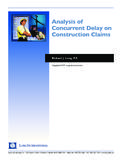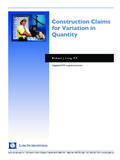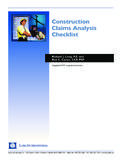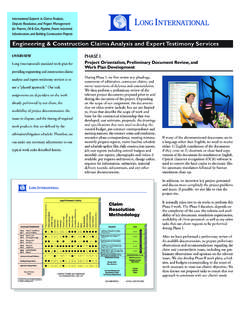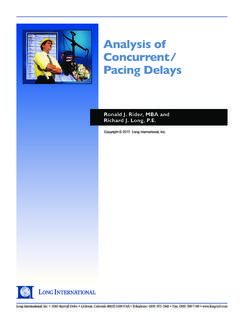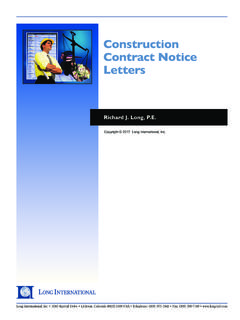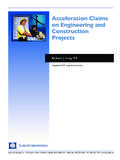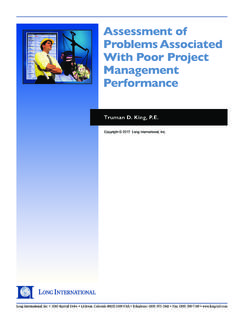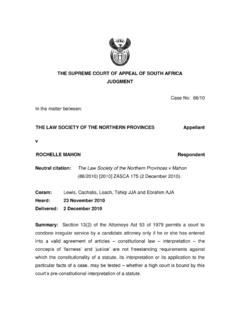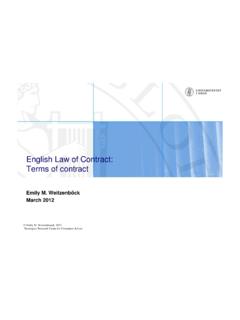Transcription of Richard J. Long, P.E. - Construction Claims Consultants
1 LONG Skytrail DriveLittleton, Colorado 80123 -1566 USAT elephone: (303) 972 - 2443 Fax: (303) 200 -7180 Long International, Inc. Richard J. Long, But-For schedule delay analysis Richard J. Long, Table of Contents 1. INTRODUCTION .. 1 2. WHY THE APPLICATION OF THE ABBF schedule delay analysis METHOD IS APPROPRIATE .. 4 3. THE AS- built CALCULATION schedule .. 8 4. QUANTIFICATION OF DELAYS .. 13 5. INTERPRETING THE RESULTS OF REMOVING DELAYS FROM THE AS- built CALCULATION schedule .. 15 6. OVERCOMING CRITICISM OF THE ABBF schedule delay analysis METHOD .. 20 List of Figures Figure 1 As- built But-For schedule analysis Methodology .. 9 Figure 2 Critical Path at the Beginning of a Window May be Different from the As- built Critical Path at the End of a Window .. 10 Figure 3 Logic Relationships at the Start of a Window May Change During the Window .. 12 Figure 4 Example of an Owner-Caused delay Quantified by a Duration Variance Calculation .. 14 Figure 5 Owner-Caused Delays Were Not on the Critical Path.
2 16 Figure 6 Owner-Caused Delays Were Fully Concurrent with Contractor-Caused Delays .. 17 Figure 7 Owner-Caused Delays Were Partially Concurrent with Contractor-Caused Delays .. 18 Figure 8 Net Overall Compensable delay for All Windows (Conceptual) .. 19 Copyright 2018 Long International, But-For schedule delay analysis 1. INTRODUCTION An As- built But-F or schedule delay Analysis1 (ABBF) is a retrospective CPM schedule delay analysis technique that determines the earliest date that the required mechanical completion activity, project completion activity, or various milestone activities could have been achieved but-for the owner-caused compensable delays that occurred during the The amount of owner-caused delay determined from the ABBF schedule delay analysis quantifies the contractor s entitlement to receive compensable delay damages. Similarly, the analysis could determine the earliest date that the various completion activities could have been achieved but-for the contractor-caused noncompensable delays that occurred during the project.
3 While the ABBF schedule delay analysis can be calculated using the entire period of the project as one as- built schedule ,3 the ABBF schedule delay analysis can also be performed in windows or periods of time, where the as- built schedule and its then current critical path can be analyzed separately for each window or period, and cumulatively for the The ABBF schedule delay analysis is calculated using the actual start and finish dates and actual work sequences of activities in the as- built schedule to determine if delay to the as- built critical path5 during the analysis period has occurred. The as- built critical path during each schedule window may be different from the planned critical path at the start of each schedule window, due to delays, scope changes, etc., that have occurred during the schedule window. Therefore, the ABBF schedule delay analysis focuses on responsibility for delays that affected the dynamic nature of the as- built critical path of the schedule window rather than delays that affected the planned critical path at the beginning of the schedule window.
4 In contrast, the Time Impact analysis (TIA) or the Update Impact analysis (UIA) adds impacts to the planned schedule to measure any potential delay . The TIA is calculated on schedules which are statused up through the day before each impact first occurred. The UIA is calculated on schedules which are statused at the beginning of a specific window or impact period, typically the monthly schedule updates prepared during the project. Often, a schedule analyst performs a TIA or UIA for the calculation of an extension of time. However, the analyst may incorrectly conclude that the total time extension entitlement or total actual delay is compensable. This conclusion may 1 Sometimes this methodology is called a Collapsed As- built schedule analysis . 2 Unless specified otherwise in the contract, concurrent contractor-caused delays and other excusable delays such as force-majeure delays, are normally noncompensable delays and, therefore, must be considered in an analysis to determine how much of the overall delay is compensable.
5 By analyzing both compensable and noncompensable delays in the as- built schedule , the analyst can determine if they are on the same or concurrent critical path and also would have delayed the project. If compensable and noncompensable delays are concurrent, and unless otherwise specified in the contract, neither the owner nor the contractor is entitled to delay damages. 3 See AACE International s Recommended Practice 29R-03 Forensic schedule analysis , MIP , April 25, 2011. 4 Id., MIP 5 See Section 3 herein for a discussion of the calculation of the as- built critical path. Copyright 2018 Long International, But-For schedule delay analysis be incorrect if the analyst fails to address concurrent delays in the as- built schedule , or if the time extension is longer than the actual delay that occurred as the result of acceleration or other delay The ABBF schedule delay analysis addresses concurrent delays, and the net period of owner-caused delay may be compensable after concurrency of contractor-caused and other excusable delays are Therefore, to avoid an incorrect conclusion, a TIA or UIA can be used to calculate the time extension to which the contractor is entitled as a result of owner-caused and other excusable delays, and the ABBF schedule delay analysis can also be used to determine the compensable delay days to which the contractor is entitled as a result of owner-caused delays.
6 The ABBF schedule delay analysis is typically more difficult to perform than the TIA or UIA because most CPM software programs regard as- built dates as historical events fixed in time. As a result, most CPM software programs will not permit but-for analysis models to be run on schedules containing actual dates. Consequently, the as- built schedule must be converted to an as-planned format containing planned dates that correspond to the as- built schedule but are driven by logic and activity durations. This conversion step is used to create an As- built Calculation schedule that can collapse as delays are The ABBF schedule delay analysis is performed by first removing owner-caused delays from the As- built Calculation schedule and recalculating the project completion date. Contractor-caused (noncompensable) and excusable/noncompensable delays are left in the As- built Calculation schedule . The As- built Calculation schedule with owner-caused delays removed is used to determine the compensable time period between the actual project completion date and the as- built but-for completion date.
7 Next, contractor-caused delays are removed from the original As- built Calculation schedule and the project completion date is recalculated. Owner-caused (compensable) and excusable/ noncompensable delays are left in the As- built Calculation schedule . The ABBF schedule delay analysis that removes contractor-caused delays is used to determine the time period between the actual completion date and the as- built but-for completion date for assessment of liquidated damages by the The conclusions derived from the ABBF schedule delay analysis are described in more detail in Section 5 of this article. 6 Contractor-caused problems may have also disrupted the contractor s work and delayed the critical path of the project. 7 Owner-caused delays may not be compensable if the contract contains a no damage for delay clause. 8 See Section 3 for a more-detailed explanation of the As- built Calculation schedule .
8 9 The TIA and UIA can also be used to determine the owner s entitlement to liquidated damages if the actual completion date is later than the impacted completion date; the difference being the number of days to which liquidated damages can be applied. Copyright 2018 Long International, But-For schedule delay analysis The following information is provided in this article: Why the application of the ABBF schedule delay analysis methodology is appropriate; The As- built Calculation schedule ; Quantification of delays; Interpreting the results of removing delays from the As- built Calculation schedule ; and Overcoming criticisms of the ABBF schedule delay analysis Method. Copyright 2018 Long International, But-For schedule delay analysis 2. WHY THE APPLICATION OF THE ABBF schedule delay analysis METHOD IS APPROPRIATE The ABBF schedule analysis is commonly used in the Construction It has been said that: The as- built but-for method is popular with both developers and contractors because, unlike the as-planned impacted method, it is based on consideration of the actual build times and can be used for determining not only the period of excusable delay , but also the period over which loss and expense may have been The same industry reference describes the cause-effect relationship derived from the use of the ABBF schedule delay analysis method.
9 The effect of the causal event on the key dates and completion date is then the difference between the date calculated before the event was subtracted, and that calculated after the event was The justification for the ABBF schedule delay analysis is that it focuses on what was actually critical over the life of the project:13 [O]ne of the arguments frequently encountered is the issue of hindsight pricing of delays, as opposed to current or contemporaneous pricing of delays. We might describe this as the need to answer a requirement or argument for the use of the but for test in the evaluation process. This should be satisfied if delays are evaluated update by update both at the beginning and end of updates, not only to identify where the critical path is located at the inception of the period but also to locate the critical path during the period and to assure that the critical path was not 10 See, for example, Wickwire, Jon M.
10 , Thomas J. Driscoll, Stephen B. Hurlbut and Scott B. Hillman, Construction Scheduling: Preparation, Liability and Claims , 2nd Edition, Aspen Law & Business, New York, 2003, Section [I] But-For Test for Extended Duration Claims , pp. 372-374, and Section [B] But For analysis /Collapsed As- built , pp. 272-273; also see Pickavance, Keith, delay and Disruption in Construction Contracts, 3rd ed., T&F Informa (UK) Ltd, London, 2005, p. 564, paragraph ; The Society of Construction Law delay and Disruption Protocol, Oxford, October 2002, Section , ; Keane, and Caletka, delay analysis in Construction Contracts, Wiley-Blackwell, 2008, Section , pp. 140-150; Forensic schedule analysis , AACE International Recommended Practice No. 29R-03, Method Implementation Protocol : Modeled, Subtractive, Multiple-Base schedule analysis , April 25, 2011. Long International has used its As- built But-For schedule analysis methodology on numerous retrospective delay analyses as experts in arbitrations and litigations regarding projects in many counties, including Argentina, Canada, England, Indonesia, The Netherlands, Norway, Saudi Arabia, Trinidad and Tobago, United States, and Venezuela.
